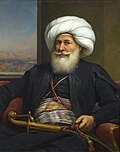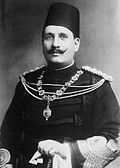Monarchs and sultans
- Muhammad Ali of Egypt – Ottoman Albanian commander in the Ottoman army, who rose to the rank of Pasha, and became Wāli, and self-declared Khedive of Egypt and Sudan [1] [2]
- Ibrahim Pasha of Egypt – Eldest son of Muhammad Ali, the Wāli and unrecognised Khedive of Egypt and Sudan [3] [4]
- Abbas I of Egypt – Wāli of Egypt and Sudan
- Sa'id of Egypt – Wāli of Egypt and Sudan from 1854 until 1863
- Isma'il Pasha – Khedive of Egypt and Sudan from 1863 to 1879
- Tewfik Pasha – Khedive of Egypt and the Sudan between 1879 and 1892 and the sixth ruler from the Muhammad Ali Dynasty
- Hussein Kamel of Egypt – Sultan of Egypt from 19 December 1914 to 9 October 1917
- Fuad I of Egypt – Sultan and later King of Egypt and Sudan
- Abbas Helmi II of Egypt – Khedive of Egypt and Sudan
- Hussein Kamel of Egypt – Sultan of Egypt
- Mohammed Ali Tewfik – Heir presumptive of Egypt and Sudan from 1892 to 1899 and 1936 to 1952


















